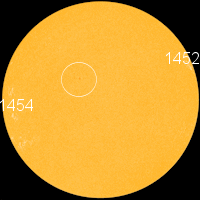LYRID METEOR SHOWER: Earth is approaching the debris field of ancient Comet Thatcher, source of the annual Lyrid meteor shower. Forecasters expect the shower to peak on April 21-22; a nearly-new moon on those dates will provide perfect dark-sky conditions for meteor watching. Usually the shower is mild (10-20 meteors per hour) but unmapped filaments of dust in the comet's tail sometimes trigger outbursts 10 times stronger. [video] [Lyrid chat] [more]
NO CME, NO PROBLEM: A CME expected to hit Earth on April 9th missed, but the Arctic lit up with auroras anyway. Yuichi Takasaka sends this report from the Northwest Territories of Canada: "Even though the CME missed, we had three outbreaks of Northern Lights at Prelude Lake." Here is one of them:
The source of the display was the IMF (interplanetary magnetic field), which tipped south on April 9th, opening a crack in Earth's magnetosphere. Solar wind poured in and fueled the auroras.
More Arctic lights are possible on April 13-14 when a high speed solar wind stream is expected to hit Earth's magnetic field. NOAA forecasters estimate a 20% chance of geomagnetic storms around the poles. Aurora alerts: text, phone.

![]()
Solar wind
speed: 330.8 km/sec
density: 3.0 protons/cm3
explanation | more data
Updated: Today at 1627 UT
![]()
X-ray Solar Flares
6-hr max: B2 1030 UT Apr11
24-hr: B2 1030 UT Apr11
explanation | more data
Updated: Today at: 1600 UT
![]()
![]()
![]()
Daily Sun: 11 Apr 12
![]()
![]()
A new sunspot is growing at the circled location. Credit: SDO/HMI
![]()
![]()
![]()
Sunspot number: 24
What is the sunspot number?
Updated 10 Apr 2012
Spotless Days
Current Stretch: 0 days
2012 total: 0 days (0%)
2011 total: 2 days (<1%)
2010 total: 51 days (14%)
2009 total: 260 days (71%)
Since 2004: 821 days
Typical Solar Min: 486 days
Updated 10 Apr 2012
The Radio Sun
10.7 cm flux: 93 sfu
explanation | more data
Updated 10 Apr 2012
![]()
![]()
![]()
Current Auroral Oval:
![]()
Switch to: Europe, USA, New Zealand, Antarctica
Credit: NOAA/POES
![]()
![]()
![]()
Planetary K-index
Now: Kp= 1 quiet
24-hr max: Kp= 3 quiet
explanation | more data
![]()
Interplanetary Mag. Field
Btotal: 6.6 nT
Bz: 6.5 nT north
explanation | more data
Updated: Today at 1627 UT
![]()
![]()
![]()
Coronal Holes: 11 Apr 12
![]()
![]()
Solar wind flowing from this coronal hole should reach Earth on April 13-14. Credit: SDO/AIA.





